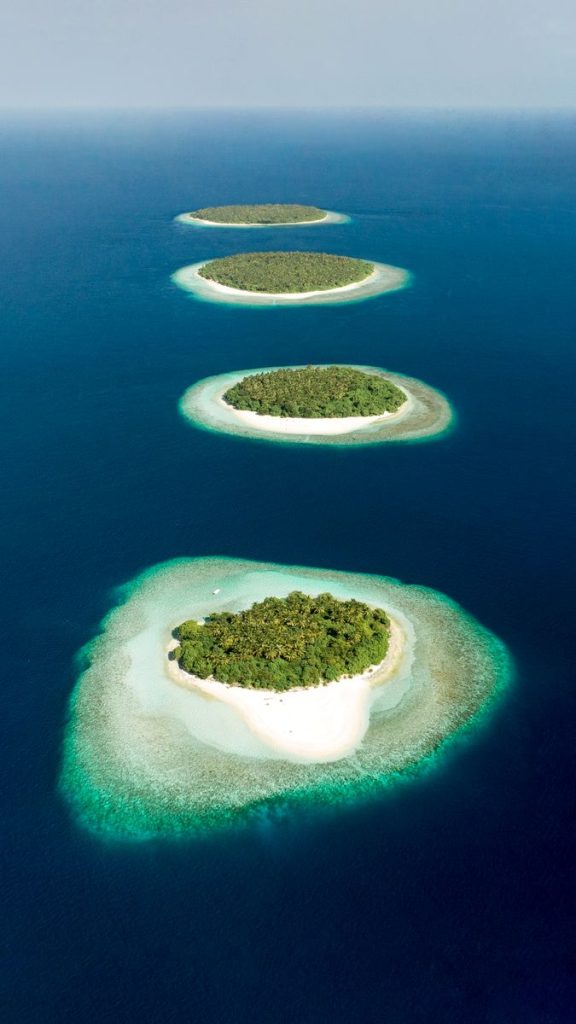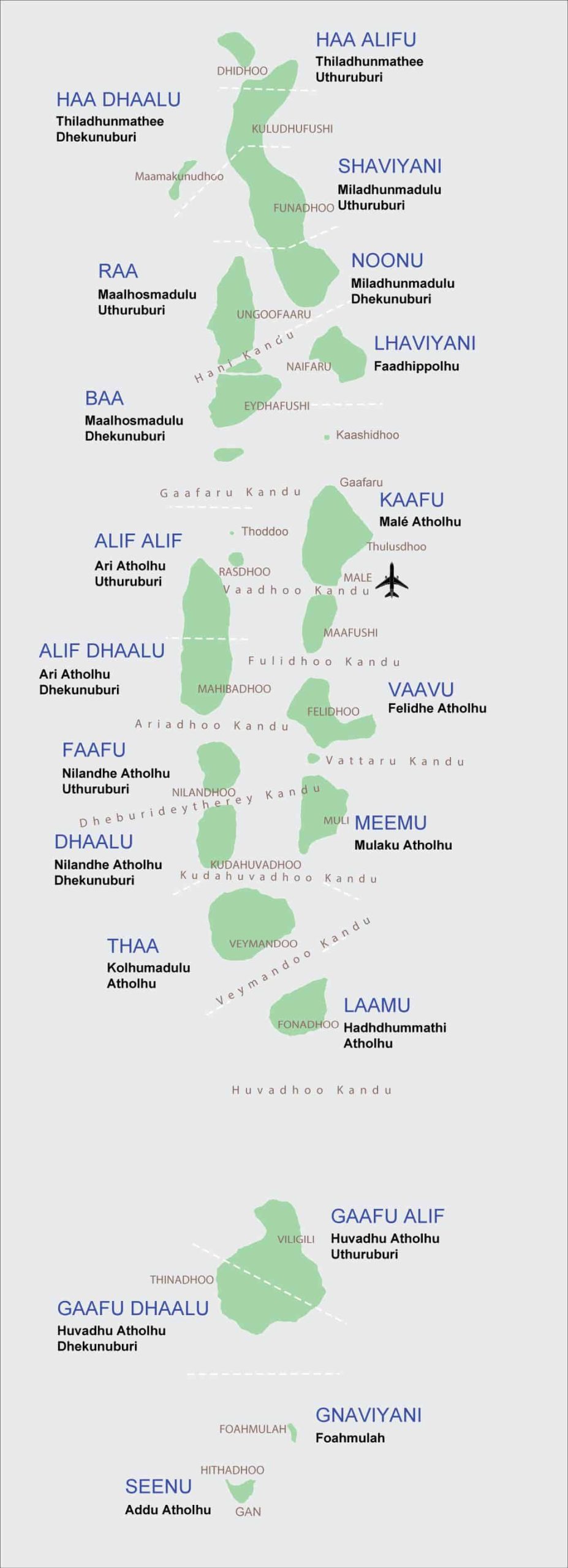Where is the Maldives islands? Location on World Map
The Maldives is an island nation in the Indian Ocean made up of atolls. The Maldives are located southwest of India and Sri Lanka on the equator, 823 kilometers north to south and 130 kilometers east to west. It consists of 26 natural atolls with 1,192 islands. Each atoll consists of numerous small coral islands surrounded by crystal-clear lagoons.

The islands are spread out over roughly 90,000 square kilometers, but only about 200 of these islands are inhabited, with many others used exclusively for tourism and agriculture.
Known for its stunning white-sand beaches, turquoise waters, and diverse marine life, the Maldives is a premier tropical getaway destination.
Your journey to the Maldives will likely begin at Velana International Airport, situated on Hulhulé Island near the capital city of Malé. From there, transportation to the other islands is typically provided by speedboat or seaplane, depending on the distance.
The Maldives boasts a variety of accommodations ranging from all-inclusive resorts to guesthouses that cater to a more budget-conscious traveler. Each resort is typically its own private island, offering a unique, secluded experience.
The equatorial position of the Maldives means it experiences a generally warm and tropical climate year-round, which is ideal for various outdoor activities such as snorkeling, diving, and water sports.
Due to its geographical layout and environmental significance, the Maldives is also actively engaged in sustainability and conservation efforts to preserve its delicate ecosystems.
With its unique geography, the country has become an example of luxury travel and environmental vulnerability coexisting side by side.
Where is the Maldives located
Maldives is an independent island nation officially know as the Republic of Maldives. The Maldive Islands are located in the Indian Ocean, southwest of Sri Lanka and India.
Location On World Map
Your first glimpse at a world map might find you searching for a while to locate the Maldives due to its dispersed formation. The Maldives is situated south-southwest of the Indian subcontinent. It’s approximately 700 kilometers (430 miles) from the Asian continent’s mainland.
To ensure clarity, here’s a more descriptive breakdown of its location:
- Continent: Asia
- Ocean: Indian Ocean
- Geographical Coordinates: About 3.2028° N latitude and 73.2207° E longitude
- Nearest Countries: Sri Lanka to the north, India to the northeast, and the Chagos Archipelago to the south
The Republic Of Maldives
The Republic of Maldives is an archipelago situated in the Indian Ocean, southwest of Sri Lanka and India. It is composed of 26 atolls, which are made up of more than 1,000 coral islands.
Geography:
Your exploration of the Maldives will reveal that the country is renowned for its crystal-clear waters, pristine beaches, and diverse marine life. The islands are dispersed over approximately 90,000 square kilometers, making it one of the world’s most dispersed countries.
Political Structure:
As a traveler, you should be aware that the Maldives is a presidential republic. The head of government is the President, who is also the head of state. Elections take place every five years, demonstrating the country’s democratic political structure.
Economy:
If you are interested in the economic aspects, the Maldives’ economy predominantly relies on tourism, fishing, and shipping. The local currency is the Maldivian Rufiyaa (MVR).
| Main Economic Sectors | Description |
|---|---|
| Tourism | The largest industry, attracting visitors to luxury resorts. |
| Fishing | Traditional livelihood, with tuna as the main catch. |
| Shipping | Transportation of goods, crucial due to the island geography. |
Cultural Insights:
You’ll find that the predominant religion in the Maldives is Islam, and it heavily influences the local culture, traditions, and laws. When engaging with locals, respect for their cultural norms and Islamic practices is essential.
Climate:
Expect a tropical monsoon climate when you visit the Maldives. Two distinct seasons are present: the dry season from November to April and the rainy season from May to October. Your planning should account for these seasonal variations.
Capital of Maldives
The capital city of the Maldives is Malé. It is the heart of the nation, both politically and economically. As you explore Malé, you will discover it’s densely populated and covers an area of approximately 8.3 square kilometers. Despite its small size, it is home to more than one-third of the Maldivian population.
Geographical Location:
| Latitude | 4.1754959 |
| Longitude | 73.5093474 |
Malé is distinct from the typical island resorts scattered throughout the Maldives. Unlike the private islands with their tranquil beaches, Malé is bustling with activity. The streets are filled with motorcycles and cars, while numerous shops and buildings line the landscape.
Key Features:
- Hukuru Miskiy: An ancient mosque dating back to the 17th century, known for its intricate coral stone carvings.
- Maldives National Museum: Here, you can immerse yourself in the rich history of the Maldives.
- Local Markets: Immerse yourself in the local culture by visiting the fish market and the lively produce markets.
To navigate within Malé, walking is the most common means due to its compact size, but you can also use taxis for more convenience. While Malé does not offer the same wide beaches as other islands in the Maldives, it provides a unique glimpse into the daily lives of the Maldivian people and their cultural heritage.
Maldives Atolls

The Maldives atolls are formed from coral barriers that encircle a lagoon. These natural structures provide a unique marine environment that supports a diverse range of sea life.
Geographical Distribution:
- Northern Atolls: Includes Ihavandhippolhu, Thiladhunmathi, Maamakunudhoo, Etthingili Alifushi, and Maalhosmadulu atolls.
- Central Atolls: Features the atolls of Faadhippolhu, Male’, Kaashidhoo, Gaafaru, and Gahaafaru.
- Southern Atolls: Encompasses the atolls of Vaavu, Meemu, Dhaalu, Thaa, and Laamu, among others.
Notable Atolls:
- Ari Atoll: Known for its clear blue waters and vibrant marine life, ideal for diving.
- Addu Atoll: The southernmost atoll, with historical significance from World War II.
Geography:
- Coordinates: 3.2028° N, 73.2207° E
- Total Islands: Approximately 1,200
- Inhabited Islands: 200
- Resort Islands: Over 100
Climate: You will experience a tropical monsoon climate, with warm temperatures year-round, complemented by a refreshing sea breeze.
Biodiversity:
- Coral Reefs: Home to around 5% of the world’s reef areas
- Marine Species: Includes manta rays, whale sharks, and a variety of fish species
Transportation:
- Main Airport: Velana International Airport (MLE)
- Travel Between Islands: Speedboats, seaplanes, and domestic flights
When planning your trip, note that tourism is regulated to ensure sustainability, with exclusive resort islands maintaining the balance between luxury and ecological impact.